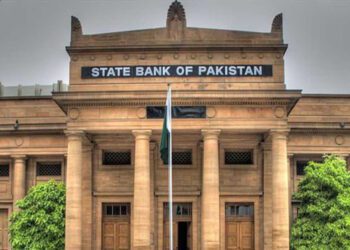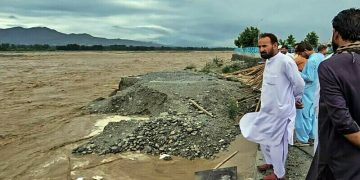Pakistan’s economy is expected to grow by only 2% in the current fiscal year ending June 2023. Inflation, the slower growth will reflect damages and disruptions caused by catastrophic floods, a tight monetary stance, high inflation, and a less conducive global environment. Recovery will be gradual, with real GDP growth projected to reach 3.2% in fiscal year 2024. Poverty in the hardest-hit regions will likely worsen in the context of recent flooding.
Preliminary estimates suggest that without decisive relief and recovery efforts to help the poor, national poverty may increase by 2.5% to 4%, pushing between 5.8 and 9 million people into poverty. Macroeconomic risks also remain high as Pakistan faces challenges associated with a large current account deficit, high public debt, and lower demand from its traditional exports markets amid subdued global growth.
The expected average rate of 9.5% in the third quarter represents a significant increase compared to the expected rate of 7.7% in the second quarter. If experts are correct, inflation for 2022 will be higher by 6.7% compare to World Bank’s average inflation over the past decade (2010 to 2019). Experts also expect high inflation worldwide in the coming years. Thus, expectations for future price increases remain high. With an average inflation rate of 7.5% in 2023, only a slight decline compared to 2022 is expected.
The idea that inflation might remain high in the longer term is shown by inflation expectations for 2026, where participants still anticipate a strongly increased inflation rate of 5.0%. There are clear differences when looking at expectations in the individual regions of the world. For 2022, the highest price increases are expected in East Africa (almost 60%), North Africa (47%), South America, and West Asia (30% each). In Southeast Asia (5.6%), East Asia (5.9%), and Oceania (6.8%), but also in North America (7.2%) and Western Europe (7.3%), by contrast, inflation expectations for 2022 are well below the global average.
There are also drastic regional differences within the continents. For example, inflation expectations in Eastern Europe (19%) are more than twice as high as in Western Europe. South Africa (7.6%) is also an outlier but higher inflation also exists in other regions of Africa. In Asia, inflation expectations are similarly heterogeneous.
As expected after floods, the Federal Committee on Agriculture (FAC) has noted that the production of sugarcane decreased by 7.9% (81.6 million tons from 88.7 million tons); rice by 40.6% (5.5 million tons over last year’s production of 9.3 million tons); maize by 3.0% (9.2 million tons versus 9.5 million tons).
The cotton production declined by 24.6% i.e. 6.3 million bales from 8.3 million bales last year. Wheat production is likely to affect as area under cultivation declines. Wheat production target for upcoming Rabi 2022-23 is fixed to the tune of 28.370 million tons from an area of 9.3 million acres. In short run, there is hardly a chance that these conditions would be improved. The decline in growth would have implications for poverty as many economies would be showing outright contraction. Higher interest rates and a strong dollar would have adverse effects on capital flows for emerging markets and developing economies, with consequences for debt burden and repayment capacities. Furthermore, this would have implications for value of imports and thus add to inflationary pressures as well. Under the circumstances, Pakistan is facing unenviable challenges.
Another concerning development is the persistence of high inflation. CPI inflation for October 2022 versus same month last year has increased to 26.6%, with urban inflation at 24.6% and rural at 29.5%. In September, inflation had come down to 23.2% from a high of 27.3% in August, it was hoped that it would moderate in coming months. However, this hope was short lived. What is more worrying is the trend in core inflation. Based on non-food, non-oil, it was 14.9% in urban and 18.2% in rural areas. The weighted average of core inflations with weights of 55% and 45% for urban and rural areas gives a core inflation of 18.25.
This level of inflation would put pressure on policy rate at 15%. The budget numbers for first quarter would not be available for another month. However, an official report of finance division shows that deficit for first two months was recorded at Rs 672 billion compared to Rs 462 billion. The primary deficit was Rs 90 billion compared to Rs 37 billion. It may be pointed out that Fund programme has envisaged steep fiscal adjustment targets which would be difficult to achieve if this pattern is not altered soon.
There are significant expenditures on account of flood support which were incurred in sub-sequent months. Besides, many new proposals for subsidies have been approved, which would add to expenditure pressures. Tax revenues increased by 17% and would face an uphill task going forward as the required overall growth is 23%. The economic slowdown would make this task quite challenging. Evidently, economic management has to balance competing demands on public resources and ensure that the choices so made are not in conflict with the demands of lenders whose support is critical for continued stability.
The biggest worries center on Pakistan’s ability to pay for imports such as energy and food and to meet sovereign debt obligations abroad. Before the floods hit, external financing needs for 2022-23 financial year (July-June) were estimated at $33.5 billion, according to Central Bank. That figure was to have been met on the back of a challenging target of almost halving the current account deficit and debt rollovers from friendly countries. The floods have changed projections. Exports are expected to slump and imports to grow to make up for essential commodities lost in the flooding of millions of hectares of farmland. Foreign exchange reserves with the central bank stand at $8 billion and commercial banks hold another $5.7 billion. That covers imports for barely a month, despite IMF funding. Pakistan’s rupee has weakened 20% since the start of the year and hit its weakest level on record in August, reflecting country’s fragile financial situation as well as strong dollar itself. The decline in currency is pushing up the cost of imports, borrowing and debt servicing, and in turn will further exacerbate inflation running already at a multi-decade high of 27.3%.
Immediate solutions include financing and compressing demand for imports, but needs are rising after the floods. However, with investors demanding a 26% premium to hold Pakistan’s international bonds over safe-haven U.S. Treasuries, Pakistan is locked out of international capital markets. There have been some indications the next IMF disbursement could be quicker and front-loaded to help Pakistan combat the floods, but the programme runs out mid-2023. The government says it expects increased financing from other multilateral lenders. Saudi Arabia, United Arab Emirates and Qatar had pledged some $5 billion in investment(s).
That would boost both finances and confidence. Energy payment facilities from Riyadh and Doha, from whom Pakistan buys liquefied natural gas (LNG), will also ease pressure on the country’s current account. Pakistan is talking to bilateral debt holders, including the Paris Club, to restructure payments. But China is the key, holding nearly $30 billion of Pakistan’s debt, including loans by its state-owned banks.
The crisis has been fuelled by political turmoil and external shocks from the global commodity crunch. Typically, a third of Pakistan’s import payments relate to energy. In the last financial year, petroleum group imports, including LNG, more than doubled to $23.3 billion from a year earlier, according to the statistics bureau. Most of its electricity is produced using LNG, prices of which remain elevated and which will be in shorter supply with the winter approaching. Higher energy bills propelled Pakistan’s current account deficit to over $17 billion – close to 5% of GDP – in the last financial year, six times higher than 2020-21, despite record high remittances from abroad.
An overheating economy also contributed to the widening deficit. Imports rose 42% to a record $80 billion in the last financial year; exports also hit a record of nearly $32 billion but grew 25%. Pakistan has never defaulted on external debt obligations. The central bank chief and the former finance minister have stressed that it was not facing imminent default. The government needs to pay $1 billion on bonds maturing in December. It has interest payments worth around $600 million for the 2022-23 fiscal year but the next full bond redemption is not until April 2024.
All major credit ratings agencies have lowered their outlook since June – all rate the country as highly speculative and risky. Pakistani officials have said the country will be able to meet short-term repayments. Another South Asian country, Sri Lanka, has defaulted on its debt and the president and government have been toppled in widespread protests caused by the economic crisis. Pakistani officials say that there are big differences between Pakistan and much smaller Sri Lanka, which had also not defaulted in modern times before the current crisis.































